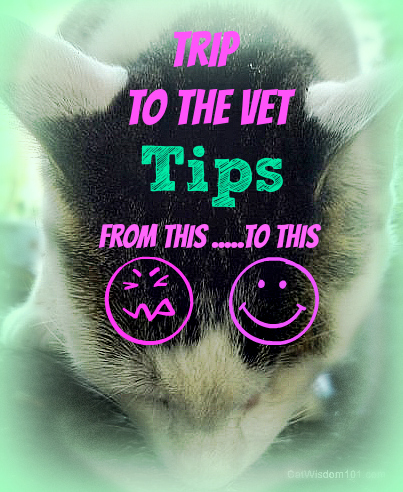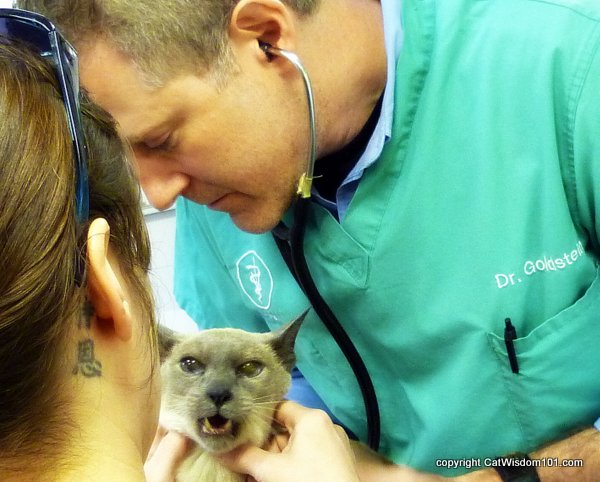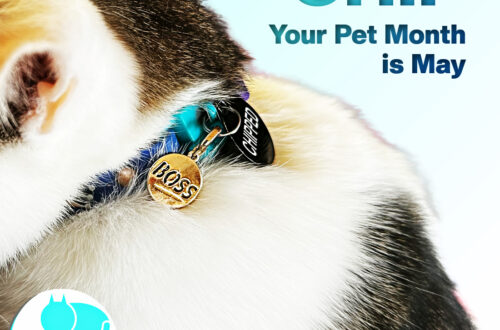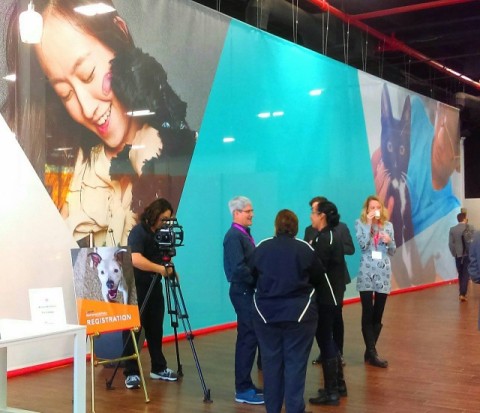Tips for Easy Vet Trips

Every Thursday we provide vet advice with a Vet 101 Q & A with our vet, Dr. Rich Goldstein or guest posts from other feline friendly vets to help you gain insights about cats. This week’s guest post is by Dr. Lorie Huston. We’re lucky to have a mobile vet who comes to our home but it’s not an option for everyone. If you have a cat who hates going to the vet, read on. Next week is Take Your Cat To The Vet Week.
Make Your Cat’s Trip to the Veterinarian Easier for You and Your Cat
Cats need regular veterinary care, just like their canine counterparts. Yet veterinarians report that they see cats much less frequently than dogs, about half as often in fact. Whatever the reason for this discrepancy, it’s a disturbing statistic.
There is likely more than reason for this oversight. Some cat
owners simply don’t understand that cats need regular examinations and routine veterinary care. They don’t realize that even a seemingly healthy cat should have a thorough examination at least once yearly and twice is better. But many cat owners also report that they avoid taking their cat to the veterinarian because of the hassle involved with getting the cat there. That’s understandable given the fact that getting a cat to do something he (or she) doesn’t want to do can be challenging. But it doesn’t have to be that way.
- The first step is to locate a cat-friendly veterinary practice. Your veterinarian can make your cat’s trip to her office much less stressful by giving your cat a special waiting area away from the dogs visiting the practice. She will also try to minimize your cat’s stay in the waiting area to lessen your cat’s anxiousness about the process. In the exam room, your veterinarian will allow your cat to come out of the carrier in his own time and let him explore the room if he so chooses. Gentle handling and minimal restraint will make your cat’s veterinary visit much less stressful as well.

Though choosing a cat-friendly veterinary practice is helpful, the journey really begins at home. Here are some tips to get your cat ready for the trip to the veterinarian and to help minimize the stress for both of you.
- When you do take your cat to the veterinarian (or anywhere else outside of your home), a carrier is a necessity. Choose a carrier that can be disassembled so the top half of the carrier can be removed easily. This will allow your veterinarian to simply take the top off the carrier and even leave your cat inside the carrier while she completes her examination if your cat does not wish to exit the carrier on his own. A soft-sided carrier that opens from the top is another option that will work well for some cats.
- Allow your cat to get used to the carrier at home, preferably long before you need to place him in it to go to the veterinarian. Leave the carrier out, with the door open, where your cat can explore it at his own pace. Place a favorite treat or toy inside the carrier to entice your cat to enter. It’s also helpful to place a towel or bed inside the carrier so that it is comfortable for your cat. Spray some Feliway (a synthetic pheromone available from your local pet store) inside the carrier as well. The goal is for your cat to view the carrier as a comfortable familiar resting place rather than a frightening trap that he only sees when something unpleasant is about to happen to him.
- Once your cat is entering the carrier freely and is comfortable in the carrier, close the door for a few moments. Don’t lock him in the carrier long enough for him to become stressed or anxious. As he gets used to idea of being in the carrier with the door closed, gradually increase the length of time.
- When your cat can rest inside the closed carrier without freaking out, take the carrier to the car. Simply place the carrier inside the car at first. Do not start the car or try to drive anywhere.
- Once your cat is comfortable with being in his carrier inside the car, start the car but don’t drive anywhere the first few times. Begin by letting the car run for just a moment or two and gradually increase the time interval. Once your cat is used to the running car, try driving around the block, just a short distance. Gradually increase the distance as your cat feels more comfortable.
- Don’t forget to reward your cat frequently during this process with a favorite treat or toy. Again, the goal is to make the experience pleasant rather than scary for your cat.
- Some cats prefer to be able to see out of the carrier during the car ride. Others do better if they cannot peer out of the carrier. If necessary, you can place a towel over the carrier to make the ride less stressful for your cat.
- Finally, take your cat to veterinarian for a social visit when he is not due for an examination or other treatment. Consult with your veterinarian’s staff about the best time to do this. There are typically less busy times in the office when the staff will have more free time to help you reward your cat with treats and make the veterinary experience a pleasant one. If your cat does not associate each visit with injections, blood draws and other painful or frightening procedures, he will be less likely to become stressed and difficult to handle.
More information about cats and carriers as well as feline-friendly practices can be found at CATalyst Council and at the American Association of Feline Practitioners (AAFP)
Visit Lorie Huston at her website.





6 Comments
The Chair Speaks
We love our vet.
Thank you for visiting us and sending comforting words.
We love you. Purrs!
Sending extra purrs to Merlin!
Our human couldn’t make out the tattoo wordings behind the ear. It looks something like ‘perseverance’ or ‘will power’ or similar to that meaning.
Tamago
These are great step-by-step tips for happy vet visit! Goro loves to nap in a carrier at home but he doesn’t like the car ride. I didn’t think about social visit to the vet. It’s a great idea!
Thank you for your comment in my blog. Goro’s skin condition is diagnosed as allergic reaction to something. We are going to have him tested and hopefully we find out what causes his allergy.
Abby
Excellent advise!!
purrs
>^,,^<
✿•*¨`*•. ♥Abby♥Boo♥Ping♥Jinx♥Grace♥✿•*¨`*•.
CATachresis
Luckily our vet is just up the road, so a very short time in the car. Austin doesn’t like it, but he deals with it fairly ok! Good advice though as always 🙂
Brian
I don’t fear the vet or my carrier, just the car, I would much rather walk to the vet!
CarenOsrinGittleman (@CatChatCaren)
good tips! I am blessed that both cats I had (and one I still have) never overly feared the vet.
I also keep the carrier out every day with the door open. It becomes familiar that way and not something to be dreaded.
In the car, if I am driving I put the carrier next to me in the front seat and spend the time talking softly, singing, laughing and playing soothing music in the car. I also use each red light for an opportunity to scritch a special nose.
If we are passengers I always hold the carrier and do everything else I mentioned.
Another important point is that because cats so easily pick up on OUR distress, as difficult as it often is because WE are nervous about a possible diagnosis (for non-routine trips) it is important to try and remain calm and not visibly stressed. It is important to feign cheerfulness and happiness because the cat will pick up on any negative or nervous energy which in turn can be transmitted to them.